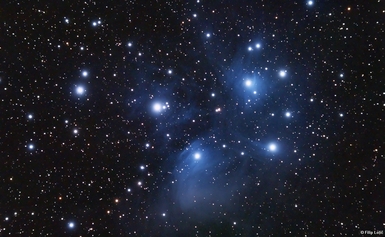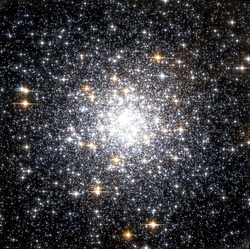3.6: Star Systems
- Page ID
- 12777
 Although constellations have stars that usually only appear to be close together, stars may be found in the same portion of space. Stars that are grouped closely together are called star systems. Larger groups of hundreds or thousands of stars are called star clusters. The image shown here is a famous star cluster classed M45, also known as Pleides, which can be seen with the naked autumn sky.Although the star humans know best is a single star, many stars—in fact, more than half of the bright stars in our galaxy—are star systems. A system of two stars orbiting each other is a binary star. A system with more than two stars orbiting each other is a multiple star system. The stars in a binary or multiple star system are often so close together that they appear as one and only through a telescope can the pair be distinguished.
Although constellations have stars that usually only appear to be close together, stars may be found in the same portion of space. Stars that are grouped closely together are called star systems. Larger groups of hundreds or thousands of stars are called star clusters. The image shown here is a famous star cluster classed M45, also known as Pleides, which can be seen with the naked autumn sky.Although the star humans know best is a single star, many stars—in fact, more than half of the bright stars in our galaxy—are star systems. A system of two stars orbiting each other is a binary star. A system with more than two stars orbiting each other is a multiple star system. The stars in a binary or multiple star system are often so close together that they appear as one and only through a telescope can the pair be distinguished.
Star clusters are divided into two main types, open clusters and globular clusters. Open clusters are groups of up to a few thousand stars that are loosely held together by gravity. Pleiades is an open cluster that is also called the Seven Sisters. Open clusters tend to be blue in color and often contain glowing gas and dust. Why do you think that open clusters have these features? Open clusters are made of young stars that formed from the same nebula. The stars may eventually be pulled apart by gravitational attraction to other objects.
 Globular clusters are groups of tens to hundreds of thousands of stars held tightly together by gravity. Figure below shows an example of a globular cluster. Globular clusters have a definite, spherical shape and contain mostly reddish stars. The stars are closer together, closer to the center of the cluster. Globular clusters don’t have much dust in them—the dust has already formed into stars.
Globular clusters are groups of tens to hundreds of thousands of stars held tightly together by gravity. Figure below shows an example of a globular cluster. Globular clusters have a definite, spherical shape and contain mostly reddish stars. The stars are closer together, closer to the center of the cluster. Globular clusters don’t have much dust in them—the dust has already formed into stars.
Check out more amazing images taken by the Hubble telescope.
Download free eBooks of Hubble imagery.
- Dynamic Earth: Introduction to Physical Geography. Authored by: R. Adam Dastrup. Located at: http://www.opengeography.org/physical-geography.html. Project: Open Geography Education. License: CC BY-SA: Attribution-ShareAlike
- M45 filip, Winter 2006. Authored by: Filip Loliu0107. Located at: https://commons.wikimedia.org/wiki/File:M45_filip.jpg. License: CC BY: Attribution
- Messier 69 Hubble WikiSky. Provided by: NASA. Located at: https://commons.wikimedia.org/wiki/File:Messier_69_Hubble_WikiSky.jpg. License: Public Domain: No Known Copyright

